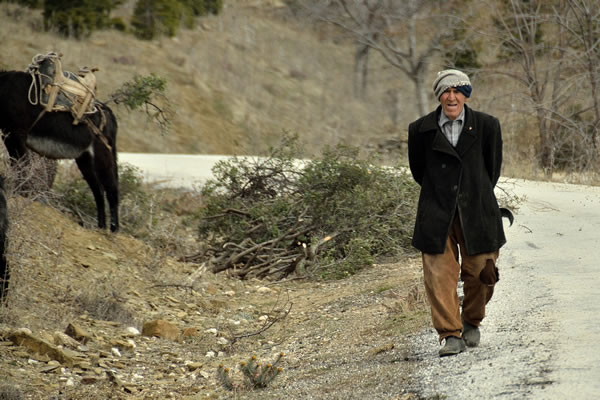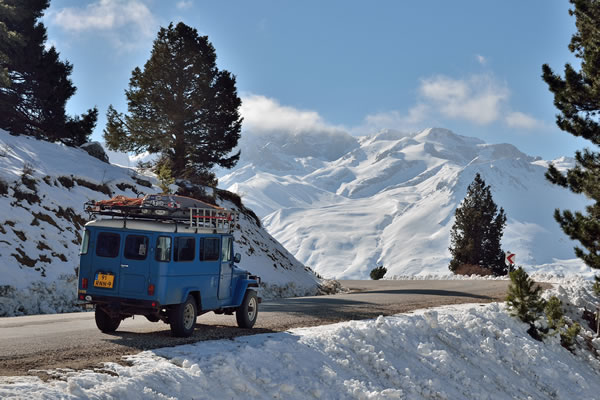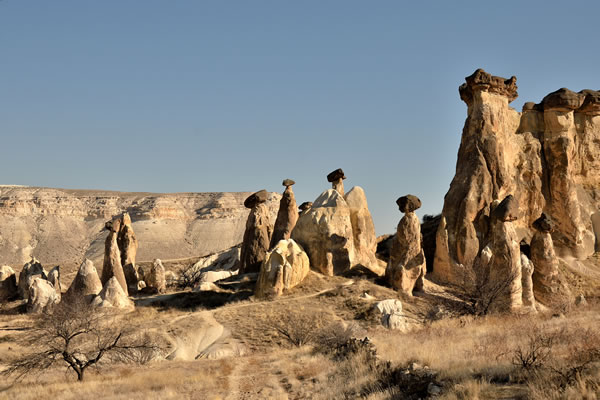|
| From Pamukkale to Cappadocia |
Sanliurfa (Turkey), February 11th 2014
|
|
|
|
Two of the biggest tourist attractions in Turkey, are the water terraces of Pamukkale and the unearthly landscape of Cappadocia. They are about 800 kilometres apart; Pamukkale is near the city of Denizli in western Anatolia, and the landscape of Cappadocia can be found around the village of Göreme, in Central Anatolia. Tourists traveling on a tight schedule and who want to see a lot in the shortest possible time, often travel by night bus between these two highlights. In this way to try to get the 'maximum' out of their journey to Turkey. For example, we met two Chinese tourists in Pamukkale who arrived early in the morning on a night bus from Cappadocia, they spent that same morning two hours at the water terraces of Pamukkale, then went to sleep in the afternoon, only to jump back into a night bus in the evening, on their way to their next destination. Madness!
Fortunately, we have a lot more time to spend, so we can also enjoy some of the beautiful places that lie between Pamukkale and Cappadocia. We have to say that Pamukkale somewhat disappointed us. Ivonne was also here twenty years ago, in the time that mass tourism was still an unknown expression in this part of Turkey. "A lot has changed since then" said a souvenir seller so strikingly when Ivonne told him that she visited Pamukkale in the nineties of the last century. Previously, visitors were allowed to bathe in the hot water terraces, spectacularly created by nature by deposition of calcium from the calcium rich waters. A spectacular natural phenomenon. However, due to the massive growth in the number of tourists, the local authorities (rightly) did decide to forbid the bathing in the terraces, and created in exchange new fake terraces to keep the tourists happy. It seems that many tourists have the non-suppressible wish to put their feet in the warm waters of Pamukkale.
|
|
Enjoying the warm waters of Pamukkale |
| |
Another consequence of the increase in the number of tourists is that the hot water terraces have become algae susceptible. And that isn’t a beautiful (and commercially desired) sight when the algae cause that the perfectly white limestone terraces, will get a yellow or greenish hue. As a result, the baths are dry significant parts of the year (the natural flow of water is diverted), so that the sun can bleach them to keep them in the perfect ‘white’ condition. A good example of how mass tourism can destroy a natural process that managed to survive for thousands, or even millions of years, and is now destroyed in just a couple of decades time by human interference. They water flow over the terraces is now managed and that means that the terraces get the water in rotation, to allow the sun to bleach the terraces when they are dry. So, if you haven’t seen them yet, you are too late and won’t see them anymore as they used to be. Pamukkale transformed itself from a destination with a natural phenomenon, to a warm water theme park.
From Pamukkale we drove east to the ruined city of Sagalassos. The classic city is certainly not the best preserved ancient city in the country, but certainly does belong to the cities with the most spectacular location. It is built against a mountain and studies show that it was already a settlement since around 1200 BC. The central square with a beautifully preserved fountain is one of the highlights of the city, as is the beautifully situated 9000-seats theatre, partially collapsed due to earthquakes, but which has remained impressively well-preserved. The special feature of this ruined city is that the materials of the city have never been looted/reused for other cities in the area thanks to its remoteness.
|
|
The well-preserved theatre of Sagalassos |
| |
Our next destination on the way to Cappadocia was Egirdir Lake. This lake and the nearby settlements were in ancient times important stopover places for passing caravans which travelled between Central Anatolia and major coastal cities such as Ephesus. The lake has a spectacular setting and is even today worth a stop. We had booked a small hotel on the Yesilada Peninsula that reaches far into the lake. Egirdir is also a great destination for day hikes. From the hills surrounding the lake you have a magnificent view on the lake.
We took a back road to the city of Konya. We drove through Aksu, Yenisarbademli and Beysehir. Hairpin roads took us to beautiful snowy passes, before we descended to the tremendous Lake Beysehir. If you leave the main roads and take the smaller ones, you will be rewarded with traditional and small Anatolian villages where time seems to have stood still for decades. Konya, however, is a metropolis of over one million people. The main reason for making a stop here is the Mausoleum of Mevlana. Mevlana was a poet and an Islamic scholar/writer from the early 13th century AD and was the founder of an important Muslim sect in Turkey, known as the Mevlevi Sufis. The mausoleum contains the sarcophagi of Mevlana and his family members, and is to this day an important pilgrimage destination for many Turks.
The last leg of the trip to Cappadocia brought us over the steppes of Central Anatolia. It was a dry and warm winter on the steppes this year, covering only the highest peaks with snow. Due to the lack of water, the steppe was yellowish coloured. We chose the village of Göreme as a base for our visit to the beautiful region of Cappadocia, created by volcanic ash. From here we made day trips in the area, mainly on foot. Not only the landscape is impressive, but also the story of human history in this area is remarkable. Especially the Byzantines (4th to 11th century AD) had a great impact by creating houses, churches, stalls and even complete underground cities in the lava rock formations, just by scratching them out of the rocks. One estimates that there are more than 100 underground cities in the area, which were built as protection against attacking armies, such as the Persians and Arabs. Some underground cities could accommodate more than 10,000 people, are a hundred metres deep, and have more than 10 underground levels! All in all a fantastic region to end or start a ride through Anatolia.
|
|
Shepherd in Central Anatolia |
|
Egirdir Lake |
|
High in the mountains of Central Anatolia |
|
Ivonne in the underground city of Derinkuyu, with a round stone 'door' to block the passage |
|
The spectacular landscape in Cappadocia
© copyright - Babakoto.eu / 2014
|








